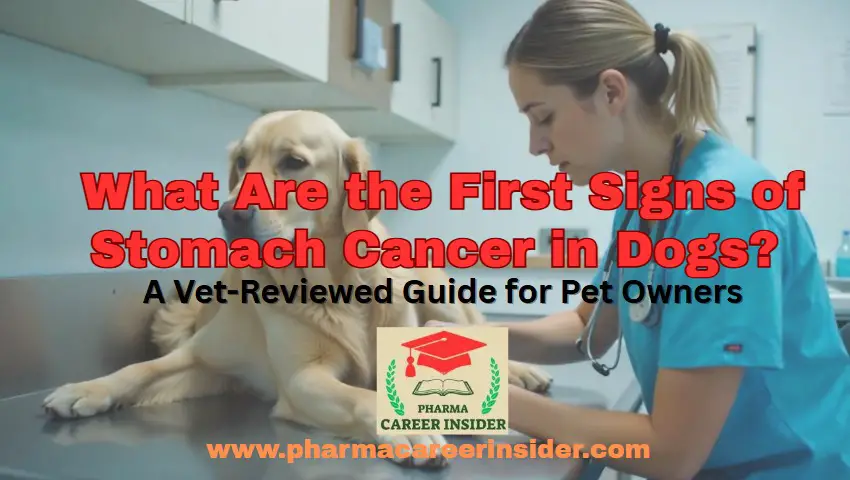Your dog isn’t just a pet—they’re family. So, when they start acting “off,” skipping meals, or vomiting more than usual, it’s normal to worry. One of the scarier possibilities that crosses a pet owner’s mind is stomach cancer. And sadly, stomach cancer in dogs often isn’t detected until it’s too late.
If you’re wondering what the first signs of stomach cancer in dogs are, you’ve come to the right place. In this post, we’ll talk about the early symptoms, what to watch out for, when to see the vet, and how to care for your furry friend if they’re diagnosed.
Let’s break it down in simple, real talk—no vet jargon, no fluff. Just helpful, heart-centered info for dog lovers like you.
What is Stomach Cancer in Dogs?
Stomach cancer (also called gastric cancer) happens when abnormal cells start growing in the lining of a dog’s stomach. These cells can form a mass or tumor that interferes with digestion and causes pain, vomiting, and other health issues.
There are a few types of stomach cancer in dogs:
- Adenocarcinoma: The most common type. It’s aggressive and spreads fast.
- Lymphoma: Cancer of the lymphatic system, which sometimes affects the stomach.
- Leiomyosarcoma: A rare cancer that grows in the stomach’s muscle layer.
- Mast cell tumors: These are usually found on the skin but can also affect the digestive system.
This kind of cancer is more common in older dogs, usually over 7 years of age. Some breeds are more at risk, including:
- Belgian Shepherds
- Rough Collies
- Staffordshire Bull Terriers
- Chow Chows
Knowing your dog’s breed risk and age can help you stay alert.
Early Warning Signs of Stomach Cancer in Dogs
So, what are the first signs that something might be wrong? Unfortunately, the early signs of stomach cancer in dogs are subtle. They might look like a minor tummy upset or a picky appetite. But over time, these signs get worse.
Here’s what to look for:
1. Persistent Vomiting
Vomiting is one of the earliest and most common signs. You might see undigested food, yellow bile, or even blood in the vomit. If your dog throws up once after eating too fast, that’s usually not a big deal. But regular vomiting—especially after meals—is a red flag.
2. Loss of Appetite
If your dog suddenly stops eating or seems uninterested in food, pay attention. Dogs with stomach cancer often feel too sick to eat. Some may eat less each day until they stop completely.
3. Unexplained Weight Loss
Weight loss can sneak up on you. If your dog’s ribs or spine feel more prominent or they look thinner, even with normal activity, it might be a warning sign of something serious.
4. Abdominal Pain or Swelling
A bloated belly or a tight, painful stomach may signal a growing tumor or internal inflammation. Your dog might whine when you touch their belly or avoid being picked up.
5. Lethargy or Low Energy
A once-playful pup who now sleeps more than usual or doesn’t get excited for walks may be struggling with illness. Cancer drains a dog’s energy, especially when it’s affecting digestion.

Other possible signs:
- Blood in stool (dark, tar-like poop)
- Bad breath
- Increased drooling
- Sudden behavior changes (like aggression or hiding)
Remember: These symptoms don’t always mean cancer. They could also point to ulcers, infections, or other treatable conditions. But it’s always better to check with your vet sooner rather than later.
How is Stomach Cancer Different from Other Digestive Issues in Dogs?
Many symptoms of stomach cancer in dogs—like vomiting, weight loss, and decreased appetite—can also be caused by more common digestive problems. This makes early detection challenging for even the most attentive pet parents.
Key differences to look for:
- Persistence and severity: Stomach upset from eating something unusual typically resolves in 1-2 days. If symptoms persist or worsen, it could be something more serious like cancer.
- Type of vomiting: Occasional vomiting may be due to dietary indiscretion. Chronic vomiting, especially with blood, may indicate stomach cancer.
- Weight loss: Gradual and unexplained weight loss is more commonly linked to cancer or chronic diseases than to temporary digestive issues.
- Behavioral changes: Dogs with stomach cancer may become withdrawn or lethargic over time—something not often seen with short-term GI issues.
When Should You Visit the Vet?
If your dog shows any of the signs above for more than a couple of days—especially vomiting, weight loss, or changes in appetite—book a vet appointment immediately.
Your vet may recommend:
- Blood tests: These check for anemia, infections, or organ damage
- X-rays or ultrasound: To see inside your dog’s abdomen
- Endoscopy: Using a small camera to look at the stomach lining
- Biopsy: Taking a small tissue sample to confirm cancer
These tests might sound scary, but they’re vital for a clear diagnosis.
Treatment Options for Stomach Cancer in Dogs
Stomach cancer in dogs is tough to treat, especially when diagnosed late. But there are still options.
1. Surgery
If the tumor is in one part of the stomach and hasn’t spread, surgery can remove it. This is often the best chance for survival, though it comes with risks and a recovery period.
2. Chemotherapy
Chemotherapy is used if the cancer has spread or surgery isn’t possible. It may not cure the cancer but can slow it down and ease symptoms.
3. Palliative Care
If treatment isn’t an option, your vet can help make your dog comfortable. Pain relievers, anti-nausea meds, and special diets can improve the quality of life.
Alternative and Holistic Approaches Some Owners Try
Some pet parents explore natural or alternative treatments alongside or in place of traditional vet care. Options like CBD oil, acupuncture, and herbal supplements are popular, but they aren’t cure-alls.
Always consult your vet before trying:
- CBD oil (may ease pain or nausea)
- Turmeric (anti-inflammatory, but needs vet approval)
- Acupuncture (may relieve pain and improve appetite)
These methods may help improve the quality of life, but they should not replace medical treatments.

How Long Can a Dog Live with Untreated Stomach Cancer?
The prognosis for dogs with untreated stomach cancer is poor. Most dogs live only a few weeks to a couple of months after diagnosis without medical intervention.
Factors affecting survival:
- Tumor type and location
- Whether cancer has spread (metastasis)
- Age and overall health of the dog
Early detection and even basic care can improve comfort and extend time with your pet.
Questions to Ask Your Vet After a Diagnosis
Getting clear answers from your vet can help you feel more prepared and empowered.
Key questions:
- What type of cancer is it?
- Has it spread?
- What are the treatment options?
- What’s the goal: cure or comfort?
- What are the costs and side effects?
- How can we keep our dog comfortable?
What’s the prognosis?
Sadly, stomach cancer in dogs often has a poor outlook. Dogs diagnosed early may live up to 6–12 months with treatment. Without treatment, life expectancy is usually just a few weeks to months.
But every dog is different—and so is every cancer. Your vet is your best source for personalized guidance.
Caring for a Dog with Stomach Cancer
It’s heartbreaking to hear that your dog has cancer, but your love and care can make a world of difference.
Here’s how you can support your dog:
Feed Small, Gentle Meals: Soft, easy-to-digest food like boiled chicken, rice, or prescription diets can ease digestive distress.
Keep Them Comfortable: Make sure their bed is soft, the house is quiet, and they’re not exposed to stress.
Watch for Pain: Panting, pacing, or licking a specific area might mean discomfort. Ask your vet about safe pain relief.
Show Them Extra Love: Gentle cuddles, slow walks, or just sitting with them can be incredibly comforting.
You’re not alone—there are support groups and pet loss counsellor’s if you ever need someone to talk to.

Can Stomach Cancer in Dogs Be Prevented?
There’s no sure way to prevent stomach cancer, but these steps can help:
- Feed your dog a high-quality diet with fewer preservatives
- Avoid giving human foods that upset the stomach
- Take your dog for yearly checkups, especially after age 7
- Know your breed’s cancer risks
- Watch for early signs and don’t ignore subtle changes
Is Euthanasia the Right Choice? When to Say Goodbye
One of the hardest parts of being a dog parent is knowing when to let go. If your dog is in pain, not eating, or no longer enjoying life, it may be time to consider euthanasia.
Signs to look for:
- Constant pain or discomfort
- Refusal to eat or drink
- Trouble breathing or moving
- No interest in favorite activities or people
Talk openly with your vet. They can guide you based on quality-of-life assessments.
Final Thoughts
Noticing early signs like vomiting, appetite loss, or fatigue might feel scary, but it’s also the first step in helping your dog. Whether it’s stomach cancer or something less serious, getting a diagnosis early gives your dog the best chance at comfort, care, and possibly more time by your side.
Your dog depends on you. And with love, attention, and a good vet on your team, you can face anything together.
Frequently Asked Questions (FAQs)
1. Can dogs survive stomach cancer?
Some dogs can survive for several months or longer with surgery and chemotherapy. However, most cases are advanced by the time they’re diagnosed.
2. Is stomach cancer in dogs painful?
Yes, it can cause pain, especially as tumors grow. Dogs may show signs like whining, shaking, or hiding.
3. What’s the cost of treating dog stomach cancer?
Costs vary by location and treatment type. Surgery may range from $2,000 to $6,000; chemo can add more. Pet insurance can help.
4. Is dog stomach cancer contagious?
No. Cancer in dogs is not contagious to other animals or humans.
5. What should I do if I can’t afford treatment?
Talk to your vet about low-cost clinics, payment plans, or hospice-style care to keep your dog comfortable.
6. How does a dog act with stomach cancer?
Dogs may vomit often, lose appetite, lose weight, seem tired, have belly pain, or act withdrawn.
7. What are the first warning signs of stomach cancer?
Early signs include persistent vomiting, appetite loss, weight loss, bloating, and low energy.
8. What is the life expectancy of a dog with stomach cancer?
With treatment, 6–12 months; without treatment, usually a few weeks to a couple of months.
9. How do dogs act when they detect cancer?
Some dogs may sniff, lick, or pay extra attention to the area with cancer, but not all dogs show this behavior.



“Valuable information in this post—thank you, Team Pharma Insider! Please keep sharing more such insightful content. Looking forward to your next post!” 🙌🐶
Really helpful and easy to understand—thanks, Team Pharma Insider! Posts like these make a real difference for pet parents. Keep the great content coming!
This post hit home. As a dog lover, I truly appreciate the clarity and compassion in your writing. Thank you, Pharma Insider, for sharing such vital info. Please keep posting more like this!